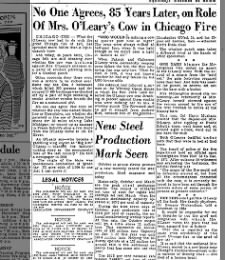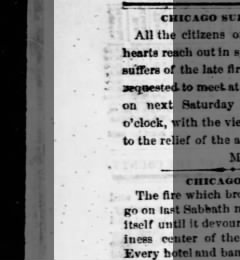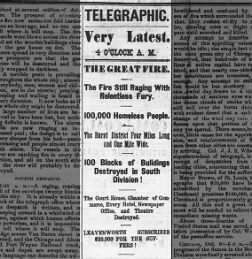

The Great Chicago Fire—a fire that would ultimately kill 300 people and destroy more than 17,000 buildings—started in a cow barn owned by Patrick and Catherine O’Leary around 9 p.m. on October 8, 1871. Although folklore states that the fire began when Catherine’s cow kicked over an oil lamp, no one really knows how the fire actually began.
It had been unusually hot and dry in Chicago, and in a city predominately built with wood, that meant the fire spread quickly. Despite the efforts of the fire department, the fire raged throughout the night, even jumping the river. Firefighters tried to fight the massive flames with their fire hoses until the city’s waterworks burned, cutting off the hydrants’ supply of water.

The huge fire burned for about another 24 hours essentially unchecked—consuming a large portion of the city, residential and business districts alike—until it began to burn itself out on the night of the 9th. A light rainstorm that same night helped douse the remaining flames. When the fire was finally out, on the 10th, an area about 4 miles long and almost a mile wide had been burned to the ground, leaving 100,000 people homeless.
Nationwide, newspapers kept their readers up-to-date on this major disaster and its aftermath, reporting the latest fire news they had received by telegraph. The papers also reported on relief efforts, as cities, businesses, and individuals across the country donated money and food to the beleaguered city.
 On the 11th, the Chicago Tribune published an issue packed with details of the fire, calling it “a conflagration which has no parallel in the annals of history.” (Though in fact the same day as the Chicago fire, October 8, the deadliest fire in U.S. history burned in Peshtigo, Wisconsin, killing more than 1,500 people; but that fire was largely overlooked by newspapers outside Wisconsin in favor of covering the Chicago blaze.)
On the 11th, the Chicago Tribune published an issue packed with details of the fire, calling it “a conflagration which has no parallel in the annals of history.” (Though in fact the same day as the Chicago fire, October 8, the deadliest fire in U.S. history burned in Peshtigo, Wisconsin, killing more than 1,500 people; but that fire was largely overlooked by newspapers outside Wisconsin in favor of covering the Chicago blaze.)
Despite the devastation of Chicago’s fire, reconstruction (this time using less wood) began almost immediately and businesses quickly reopened, though many in new locations. Within a little more than 20 years, Chicago would rise from its ashes to become a booming city deemed worthy of hosting the 1893 World’s Fair.
Find more articles about the Great Chicago Fire on Newspapers.com. You might even find your Chicago ancestors in the lists of people missing or “lost and found” following the fire.


On the same day, in the same year; the most devastating fire in American History took place. The Peshtigo forest fire killed more than 1,700 men, women and children; yet history has all but ignored this event. I do understand the Nation wide interest in the big Chicago fire at the time, but I don’t know why most of the school systems across America don’t even mention this horrendous loss of American lives.
I have never heard of the Wisconsin Fire and I am 68. Thank you Patrick.
I was a Fire Prevention Inspector for the Fire Department for about 10 years. We heard all about the Chicago fire and the O’Leary cow, but were never told about the Wisconsin fire.
Thank you, Patrick Fogarty, for your post. I bothers me every year at this time when mention is made in national news of the Great Chicago Fire and no mention is made of the Peshtigo Fire, which burned in both Wisconsin and Michigan, with the fire jumping across from the western shore of Green Bay to the eastern shore and Door Co., Wis. I had members of a family line who suffered losses in the Pestigo Fire. Plus, William Butler Ogden, a relative of mine, not only lost a great deal of his holdings in Chicago, including his estate there, but also property in and around Pestigo.
I also have not heard of the Peshtigo fire. Thank you for mentioning it. Going now to further study this.
http://www.peshtigofire.info/
I HAD NEVER HEARD ABOUT THE WISCONSIN FIRE AND I AM 68. THANK YOU PATRICK.
Look for the book “Fire and Ice”, which is about the Peshtigo Fire. Until a family member had read it, we were just as unaware of this devestating fire.
I grew up in Wisconsin and the Peshtigo fire was part of our history classes. Don’t know if it still is the case. Didn’t learn much about the Chicago fire until I read about it as an adult.
I read the book on the Pestigo, WI fire. It was surreal. Heat so great that railroad ties were melted. Fire storms which killed people from hundred of yards away. I remember reading that one family tried to lower their children into a well to escape the fire and even that was fruitless. Strangely enough it may have been started intentionally as a controlled burn which do to the horribly hot and dry weather along with winds let it get out of control.
Very interesting posts! I think this is the way history should be taught, with a real newspaper. I am not sure if many have heard the old hymn “It is well with my soul” but I have always been moved by the lyrics. The writer was Horatio Spafford, a Chicago resident during the fires. I have provided a link…
http://gnli.christianpost.com/video/moving-story-behind-the-famous-hymn-it-is-well-with-my-soul-26895
I had studied the Chicago fire during a past genealogical research project and learned a missing family was victim of that fire. Even then, I had not learned of the Peshtigo, WI, fire of 8 Oct 1871, where as many as 2500 people may have died. I have since learned that the cities of Port Huron, Holland and Manistee, MI, also burned on 8 Oct. Possibly as many as 200 people died in Michigan that day. Interest in Chicago simply overshadowed that of the other localities.
My 3rd-great-grandparents John Bennet Winters and Anna “Ann” (Walker) Winters and their daughter, my 2nd-great-grandmother Catherine Elizabeth Winters, were living in Chicago at the time of the fire and were probably affected by it. It is possible that Elizabeth’s future husband James Graham and his family were also affected by the fire, but I need more evidence that I have found the right person.
Back when the fire was going on there was not any communications like today
Only the telegraph and newspapers that only went in local areas
When I was in school we read about it when we lived in Mattoon,Ill about 200 miles from Chicago
Plus we lived in E Chicago in the 40s and I went to kindergarten and my siblings were in higher grades
Today everything is instant
I saw a movie with Errol Flynn in it about the fire also
Being in the building business here in a small town we had a similar thing when a storm hit and one of the building caught on fire and wiped out 4or 5 buildings
They were also wood
After that they passed new building codes on main street where the buildings had to be built out of concrete/steel/blocks/ anything that would not burn like the old ones did
In a way it was a blessing because when the buildings were rebuilt now we have a like new main street and the buildings are modern now
So there is bad & good about the whole thing
We also had a small tornado that wiped out the other side and it was also rebuilt
Which we almost have a new main street
I have worked on fires and tornados and the best is the tornados because it is cleaner where the fire even after it is removed even the foundation and the ground around it is black
With white carpenters pants on it destroyed them so I had to wear my black ones until it was built
Most people would not think about it unless they have been there like I have been
It is just a minor bit of useless information
As an Atlanta native, with relatives in Chicago, I had heard of that fire,however, we had a really devastating fire here as well. The burning of the beautiful southern city of Atlanta cut a fifty mile wide hell, earning Atlanta the name, ” City of the Phoenix” after the war
I think most everybody New or read about the great Chicago
Fire but I have never heard or read about the other fire. Not
Even in our school history class was this fire mentioned.
We did a study on the Chicago fire and I’m in England. But our disaster was the great fire of london
My daughter’s father’s family is one of the settling families of Peshtigo. Two of his relatives perished in the Great Fire – two small girls. According to his family lore, many of his relatives survived by going into the Peshtigo River. There is a poignant, but small museum in Peshigo highlighting the impact of the fire in the North Woods.
http://peshtigofiremuseum.org/
The Great Hinckley Fire of 1894, in Hinckley MN, killed up to 800 people. There’s a great fire museum there.
I knew about the Peshtigo conflagration–kind of a footnote in a Chicago Fire book–and 11 years ago, driving through Wisconsin on the anniversary and listening to public radio in the car, I learned a lot more. A few years ago, a proposed high-rise in Streeterville was going to be named The Peshtigo, based solely on the short street down there commemorating the simultaneous disaster. I had a chance to speak with someone involved with it and pointed out that naming a residential building after the deadliest fire in U.S. history had questionable merit. That project never went through, and a more modest development was simply named for the street address.
I am interested in knowing who some of the firemen were that fought the Chicago fire. My Great Grandfather John Bartchlett was a fireman and lived in Toledo, Ohio. His son, Willard Bartchlett was also a fireman and lived in the same area. Least History forget, there was also a Great Fire in Jacksonville, Florida in the 1900’s that burnt the city to the ground. Fire is a terrible thing when out of control. Thank God for the faithful few that serve to protect us and our property.
I have a question. I am from the Niagara County Historical Society Lockport, NY, home of the first fire hydrant system in the United States invented by local resident Birdsill Holly. We have always read and been told that Chicago did not purchase Holly’s hydrant system and that is why the fire was so devastating. However the above article states that there were hydrants in place at the time of the fire. Does anyone know if they were Holly hydrants or were from some other company or if there were really hydrants in Chicago at the time of the fire. I would like to clear this up. Thank you.